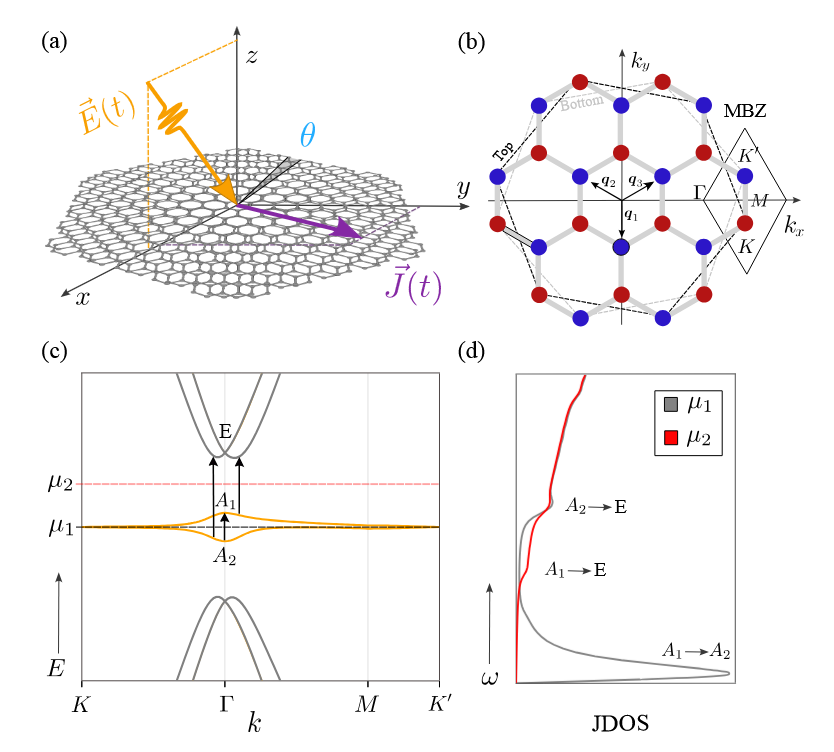Photogalvanic effects in twisted bilayer graphene
Twisted bilayer graphene (TBG) has garnered significant attention due to its unique electronic properties, especially when the two graphene layers are misaligned by a specific “magic” angle. This misalignment leads to the formation of moiré patterns, resulting in flat electronic bands that enhance electron interactions and give rise to phenomena such as superconductivity and insulating states.
Now, a team of researchers delves 1 into the photogalvanic effects in TBG, where light exposure generates a direct electric current without the need for an external voltage. This phenomenon is particularly intriguing in materials lacking inversion symmetry, like TBG, and holds promise for applications in optoelectronics and photovoltaic devices.
Intrinsic Photogalvanic Effects in TBG
In its natural state, TBG possesses a chiral lattice structure with D₆ symmetry, which lacks inversion symmetry but retains certain rotational symmetries. This configuration permits intrinsic photogalvanic effects, but only when light is incident at an angle (off-normal incidence). The study reveals that these intrinsic effects undergo a sign reversal at the magic angle, indicating a band inversion at a specific point in the electronic band structure known as the Γ point. This inversion suggests a significant alteration in the electronic properties of TBG at the magic angle, influencing how electrons respond to external stimuli like light.

Extrinsic Photogalvanic Effects
Beyond intrinsic effects, extrinsic photogalvanic effects can emerge when external factors break the inherent symmetries of TBG. For instance, placing TBG on a substrate or applying a perpendicular electric field (displacement field) can reduce its symmetry, enabling additional photogalvanic responses even under normal light incidence. The researchers examine these extrinsic effects, demonstrating how they can serve as indicators of the strength of substrate interactions or the magnitude of the applied displacement field. By analyzing these extrinsic photocurrents, researchers can gain insights into the degree of symmetry breaking and its impact on the material’s electronic behavior.
Chemical Potential and Photocurrent Behavior
The research also highlights that the approximate particle-hole symmetry in TBG imposes strict constraints on how photocurrents vary with changes in chemical potential (which can be adjusted by doping or gating). This symmetry implies that the photocurrent’s dependence on the chemical potential follows specific patterns, providing a deeper understanding of the underlying electronic structure and guiding the design of experiments and devices that leverage these photogalvanic effects.
Implications and Applications
Understanding both intrinsic and extrinsic photogalvanic effects in TBG is crucial for several reasons:
- Probing Band Structure: Photogalvanic measurements offer a non-invasive method to explore the electronic band structure of TBG, shedding light on phenomena like band inversion and the role of symmetry.
- Device Engineering: Insights into how external factors influence photogalvanic responses can inform the design of optoelectronic devices, such as photodetectors and solar cells, that exploit these effects for improved performance.
- Benchmarking Correlated States: By comparing intrinsic and extrinsic photocurrents, researchers can assess the symmetry-breaking patterns of correlated electronic states in TBG, enhancing our understanding of complex quantum phases in this material.
In summary, this study provides a comprehensive analysis of the photogalvanic effects in twisted bilayer graphene, elucidating how intrinsic properties and external perturbations influence the generation of photocurrents. These findings not only deepen our understanding of the fundamental physics of TBG but also pave the way for developing advanced materials and devices that harness these unique optical and electronic properties.
Author: César Tomé López is a science writer and the editor of Mapping Ignorance
Disclaimer: Parts of this article may have been copied verbatim or almost verbatim from the referenced research paper/s.
References
- Fernando Peñaranda, Héctor Ochoa, and Fernando de Juan (2024) Intrinsic and Extrinsic Photogalvanic Effects in Twisted Bilayer Graphene Phys. Rev. Lett. doi: 10.1103/PhysRevLett.133.256603 ↩